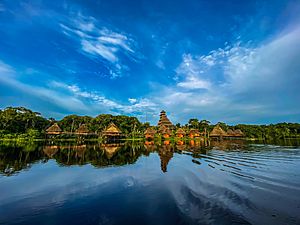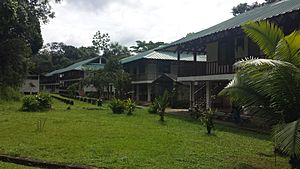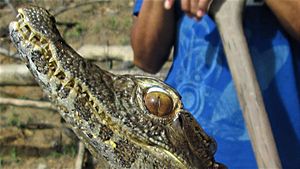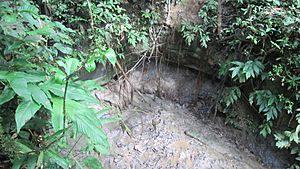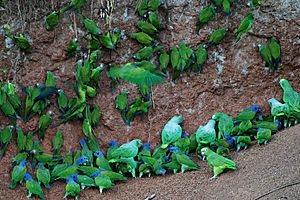Yasuní National Park facts for kids
Quick facts for kids Yasuni National Park Llanganates |
|
|---|---|
|
IUCN Category II (National Park)
|
|

Yasuni National Park (dark green).
|
|
| Location | Napo and Pastaza province |
| Area | 9,823 km2 (3,793 sq mi) |
| Established | 26 July 1979 |
Yasuni National Park (which means Parque Nacional Yasuní in Spanish) is a huge protected area in Ecuador. It covers about 9,823 square kilometers, which is a bit bigger than the country of Cyprus! This amazing park is located between the Napo and Curaray Rivers in the Amazon rainforest of Ecuador.
The park is mostly made up of thick rain forest. It's about 250 kilometers away from Quito, the capital city of Ecuador. In 1989, UNESCO named Yasuni a UNESCO Biosphere Reserve. This means it's a special place where people try to balance nature conservation with human activities.
Yasuni National Park is also the home of the Huaorani indigenous people. It's also where two uncontacted indigenous tribes, the Tagaeri and the Taromenane, live. Many local people use the rivers in the park to travel around. Some of these rivers flow into the mighty Amazon River.
Contents
What Makes Yasuni National Park So Special?

Yasuni National Park is thought to be one of the most biologically diverse places on Earth. This means it has an incredible variety of plants and animals. It's a special spot where the Equator, the Andes Mountains, and the Amazon rainforest all meet.
The park holds world records for the number of different trees, amphibians (like frogs), and bats found in small areas. It's also one of the richest places for birds and mammals. Even though Yasuni is less than 0.15% of the Amazon Basin, it's home to about one-third of all the amphibian and reptile species in the Amazon.
Scientists have found 382 different kinds of fish here. The park also has at least 596 bird species, which is one-third of all the native birds in the Amazon. Yasuni is also home to many types of bats. In just one hectare (about the size of a sports field), Yasuni has over 100,000 different kinds of insects! That's roughly the same number of insect species found in all of North America.
The park also has an amazing variety of plants. It's one of only nine places in the world with over 4,000 different kinds of vascular plants (plants with tubes to carry water) in a 10,000 square kilometer area. Yasuni holds several world records for the number of trees and climbing plants called lianas. It also has many unique species that are found nowhere else.
Mammals of Yasuni
Many different kinds of mammals live in Yasuni National Park. They live in the water, on land, and in the air. The Giant Otter (called Pteronura brasiliensis) is an endangered species that lives in the rivers here. These otters have to adapt to changing water levels throughout the year.
A special type of bat, Lophostoma yasuni, is found only in this park. Many kinds of monkeys live high up in the trees, like the Eastern Ecuadorian Squirrel Monkey and the Pygmy Marmoset. These monkeys are very important for the ecosystem. They help spread seeds and eat insects, keeping the forest healthy.
Amphibians and Reptiles
Even though Yasuni is a small part of the Amazon, it has about one-third of all the amphibian and reptile species found in the entire Amazon Basin. The park holds a world record with 150 different amphibian species. One type of treefrog, Osteocephalus yasuni, is even named after the park! Scientists have found 121 different reptile species here.
Fish in the Rivers
The park's rivers are full of fish, with an estimated 500 different species! This number might even be higher because some fish species look very similar but are actually different when studied closely using DNA. The variety of fish changes depending on the season and the type of river habitat.
Birds of the Rainforest
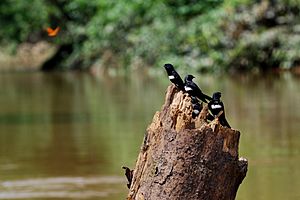
Yasuni is home to at least 596 bird species. This means one-third of all the native bird species in the Amazon live here! You can find many kinds of birds, including falcons, hawks, eagles, macaws, and hummingbirds. The different layers of the forest canopy provide homes for many birds, including pollinators like hummingbirds that help plants reproduce.
Insects: Tiny but Mighty
This national park has an incredibly high number of different insects. It also has many examples of insects and plants helping each other. In just one hectare, Yasuni has over 100,000 different species of insects! This is roughly the same number of insect species found in all of North America.
Plant Diversity: A Green Wonderland
The park is also one of the richest places in the world for vascular plants. It's one of only nine places globally that has over 4,000 different kinds of vascular plants in a 10,000 square kilometer area. The park has many types of trees and shrubs. It holds at least four world records for the number of documented trees and lianas (climbing plants). It also has three world records for the variety of woody plant species.
Oil and the Park's Future
Yasuni National Park sits on top of a lot of crude oil, about 1.7 billion barrels! This is 40 percent of all of Ecuador's oil. Many environmentalists and scientists, like Jane Goodall, asked the government to leave this oil in the ground. Indigenous people and environmental groups wanted the public to vote on whether to drill for oil in the park.
In 2007, Ecuador's President Rafael Correa started the Yasuní-ITT Initiative. This plan aimed to protect the park's natural resources. The government promised not to drill for oil in the park if other countries would pay Ecuador for this decision. Not drilling would prevent 400 million metric tons of carbon dioxide from going into the air. Ecuador hoped to raise US$3.6 billion over 12 years. Many people praised this plan as a new way to help poorer countries protect their environment.
Famous people like Leonardo DiCaprio and Al Gore supported the plan. Countries like Turkey, Spain, and Belgium also promised money. However, Ecuador wanted to decide how the money would be spent, which made some countries hesitant to contribute.
In 2013, President Correa ended the plan. He said that the world had "failed" Ecuador because not enough money was given. He mentioned that only US$336 million had been promised, and only US$13.3 million had actually been received.
Correa said that drilling for oil was important for Ecuador's economy and to help the country's poor. He stated that drilling would only affect 1% of the Yasuni area and could be done without harming the environment. However, environmentalists strongly disagreed and protested the decision. Oil production makes up one-third of Ecuador's national budget.
Other Challenges for the Park
Besides oil drilling, Yasuni National Park faces other challenges. These include people moving into the area, cutting down trees, illegal logging, and hunting animals unsustainably.
See also
- Finding Species
- Tiputini Biodiversity Station
 In Spanish: Parque nacional Yasuní para niños |
In Spanish: Parque nacional Yasuní para niños |


